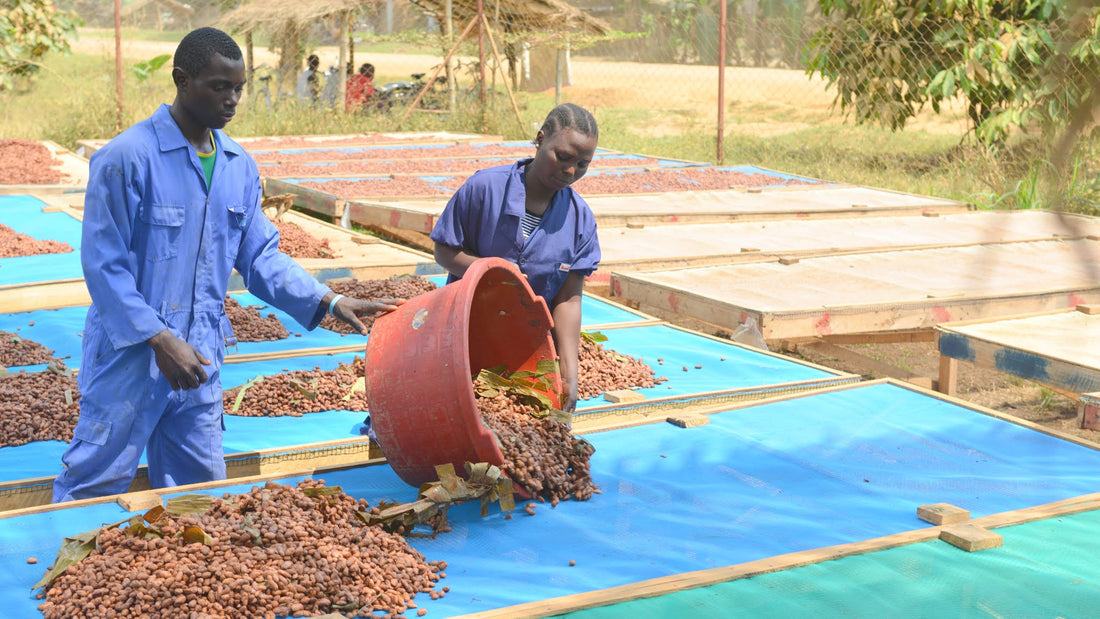
Alleviating Cocoa Waste
Share
At origin, up to 70% of the whole cacao plant is considered waste and leftover by-product. This includes cocoa pod husks, cocoa bean shells, and cocoa sweatings. Also referred to as cocoa pulp, cocoa sweatings are the pale white to yellowish liquid that seeps out during cocoa fermentation. Each part of the whole cocoa pod is rich in vitamins, minerals, and antioxidants that have proven health benefits. In recent years, much work has been done to utilize cocoa by-products in supporting alternative food systems, paper supplies, pharmaceutical advantages, and notably within the cosmetic industry. Continuing to support and develop these biotechnological approaches serves to increase viable cocoa waste management alternatives.
Ways to use up discard from the chocolate making process:
Pulp - When cocoa beans are separated from the pulp, the beans are fermented before they’re turned into chocolate. The leftover cocoa pulp may be pressed into a fruit juice that is filtered and pasteurized. This liquid is the resulting breakdown of the mucilage surrounding the fresh cocoa bean, and constitutes about 10% of the weight of the cocoa fruit. Because of its easily fermentable residual sugar, pulp can be turned into cocoa wine, alcohol, syrup, and jam.
Cascara – Spent cocoa shells are dried and ground into a fine powder. Cascara, meaning “husk,” or “skin” in Spanish, is the dried skins of coffee cherries. The same is true for cacao, once the bean inside the cacao fruit has been harvested, the shells are discarded as waste. These husks are rich in fiber, antioxidants, Iron, Calcium, Vitamin A, Vitamin E and C, and the naturally occurring stimulant theobromine. This powder can be used as an addition to flour, gluten-free flour, bread mixes, and more.
Cacao Water - Cacao water is rich in antioxidants, electrolytes, and soluble dietary fiber. Cacao water is made from the cacao fruit – that’s the white, fleshy part of the whole cacao that surrounds the beans – and it’s full of superfood benefits that make cacao water a healthy alternative to plain water for advanced hydration and wellness benefits.
Cacao Shell Tea - After the winnowing process, you don’t have to say goodbye to the separated shells just yet. They can make a unique and refreshing tasting tea that still gives you a light taste and aroma of the roasted cacao. Simply steep shells in boiling water with preferred additions like honey, lemon, mint leaves, or sugar to enjoy.
Brewing Cacao- Very similar to making tea with the shells, this method involves both crushed shells and nibs to make a drinking cacao. Place shells and nibs in a French press and add boiling water. Steep for 5 to 7 minutes before pressing. This could give a second life to beans that get sorted out of the bean to bar process. The flats, the ones too small, the ones that already come crushed, turn them into a caffeine crash-free alternative to coffee!
Vanilla Pods- After using the caviar inside the beans there are many ways you can extend the life of the vanilla. Leftover vanilla pods have myriad of uses: extract, spirits, sugar, powder, syrup and more.
Vanilla Extract - Though normally one would slice and use the whole vanilla pod to make an extract, reusing the leftover pod and remaining bits work too. Toss the scraped pods into a bottle of vodka or high-proof grain alcohol. Allow the mixture to sit for at least two months. Shake bottle to disperse settlement. Let mixture sit longer for more depth of flavor.
Vanilla Vodka - Same process as above but the vanilla beans steep in the vodka for only a week.
Vanilla Sugar - Place scraped vanilla bean into an airtight container with granulated sugar.
Vanilla Maple Syrup - Same method for the syrup as the extract and vodka. Place the vanilla pod into a jar of maple syrup and let rest.
Vanilla Powder - Dry used vanilla beans completely. Grind in a food processor or spice grinder.
Vanilla Simple Syrup - While boiling equal parts water and sugar together, toss in the vanilla beans.
